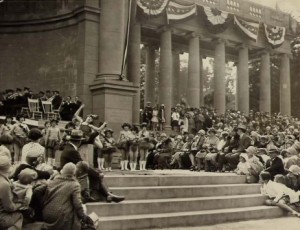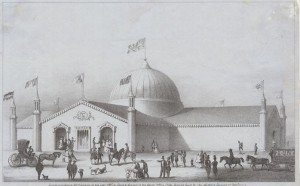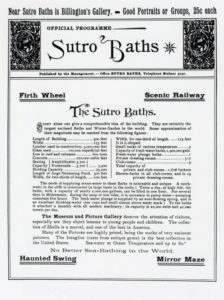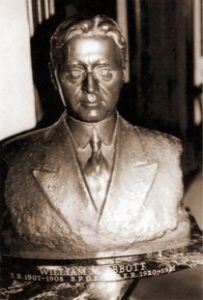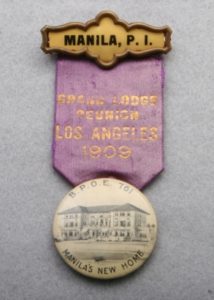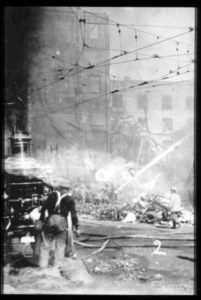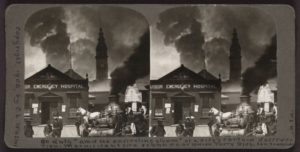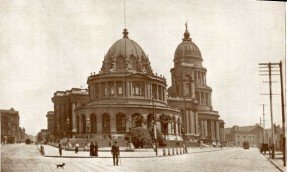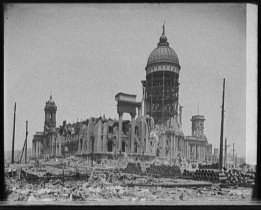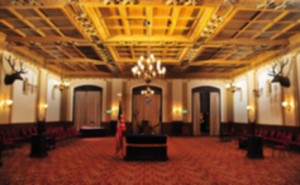The Beginning of the Benevolent and Protective Order of Elks on the West Coast
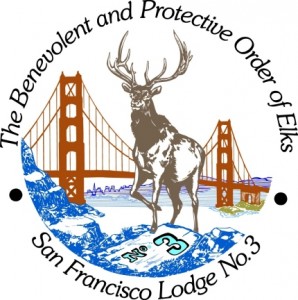
The History of the
San Francisco Elks Lodge No. 3
1876 to 1925
(The fabulous story about our unique and proud heritage)
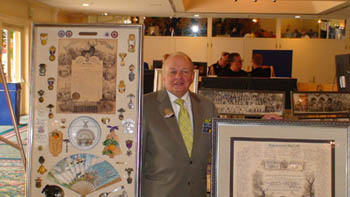
Trill Torrillhon, CHEA Historian
The Founding
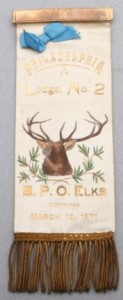 The history of the San Francisco Elks Lodge No. 3 is inextricably bound to the Benevolent and Protective Order of the Elks (B.P.O.E.). In the 1903 the book about the Founder of the Benevolent and Protective Order of Elks, the Biography of the Life of Charles Algernon Sidney Vivian, was published in San Francisco by Charles Vivian’s widow, Imogene. Vivian is recognized as the founder of the Jolly Corks, the predecessor to the great organization. On February 2, 1868, at a meeting presided over by Charles Vivian, a committee of the Jolly Corks was formed to examine the possibility of reorganizing into a Lodge with benevolent and protective goals (as opposed to continuing as solely a social and drinking organization). On February 16th the committee made its report, recommending that the Jolly Corks become the Benevolent and Protective Order of Elks. Since Charles Vivian preferred the name “Buffalos,” a heated discussion followed, and the name ‘Elk” was selected with an eight to seven vote. Thus the first Elks Lodge was established, on this date, February 16, 1868, in New York City. The second Elks Lodge would be formed in Philadelphia on February 19,1871. Five years later, San Francisco Elks Lodge No. 3 was formed. It is interesting to note that Charles Vivian was never fully initiated as an Elk. At the time Vivian founded the order, the Order required two levels of initiation, first and second degree. Elks weren’t considered full members until they had completed the second degree initiation. Vivian was never initiated into the second degree, and thus was never considered a member of the Order. He continued his work on behalf of the Jolly Corks, which continued as a separate organization for a period of time, including a lodge in San Francisco.
The history of the San Francisco Elks Lodge No. 3 is inextricably bound to the Benevolent and Protective Order of the Elks (B.P.O.E.). In the 1903 the book about the Founder of the Benevolent and Protective Order of Elks, the Biography of the Life of Charles Algernon Sidney Vivian, was published in San Francisco by Charles Vivian’s widow, Imogene. Vivian is recognized as the founder of the Jolly Corks, the predecessor to the great organization. On February 2, 1868, at a meeting presided over by Charles Vivian, a committee of the Jolly Corks was formed to examine the possibility of reorganizing into a Lodge with benevolent and protective goals (as opposed to continuing as solely a social and drinking organization). On February 16th the committee made its report, recommending that the Jolly Corks become the Benevolent and Protective Order of Elks. Since Charles Vivian preferred the name “Buffalos,” a heated discussion followed, and the name ‘Elk” was selected with an eight to seven vote. Thus the first Elks Lodge was established, on this date, February 16, 1868, in New York City. The second Elks Lodge would be formed in Philadelphia on February 19,1871. Five years later, San Francisco Elks Lodge No. 3 was formed. It is interesting to note that Charles Vivian was never fully initiated as an Elk. At the time Vivian founded the order, the Order required two levels of initiation, first and second degree. Elks weren’t considered full members until they had completed the second degree initiation. Vivian was never initiated into the second degree, and thus was never considered a member of the Order. He continued his work on behalf of the Jolly Corks, which continued as a separate organization for a period of time, including a lodge in San Francisco.
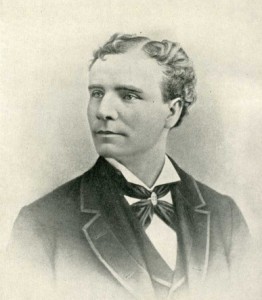 Since the majority of Elks were actors and entertainers, they traveled extensively throughout the country. In 1873 members found themselves in San Francisco, where they decided to organize a lodge. On June 8, 1873, the fifth regular communication, and the fourteenth session of the B.P.O.E Grand Lodge was held at the in the Masonic Hall in New York City. The following communication dated April 26, 1873 was received and read:
Since the majority of Elks were actors and entertainers, they traveled extensively throughout the country. In 1873 members found themselves in San Francisco, where they decided to organize a lodge. On June 8, 1873, the fifth regular communication, and the fourteenth session of the B.P.O.E Grand Lodge was held at the in the Masonic Hall in New York City. The following communication dated April 26, 1873 was received and read:
“To Grand Lodge, B.P.O.E. New York City: We the undersigned members of the above-mentioned honorable order, now residing in San Francisco, respectfully request that you grant us a charter to form a branch lodge in this city. The good that the Order will derive from such a charter will be fully explained by Brothers Smith and Ryman.”
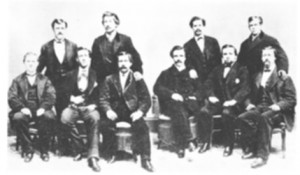
10 of the 15 original members of the Jolly Corks who founded the BPOE. From left E. W. Platt, Frank Langhorne, William Carelton, William Sheppard, Richard R. Steirly, Charles A. Vivian, John T. Kent, Henry Vandemark, Harry Bosworth, M.G. Ash
This letter was signed by ten people, and was referred to a special committee comprised of members Gus Phillips, R.S. Martin, and Henry O’Neil. O’Neil, on the same date, June 8th, recommended that the charter be granted immediately; that it be placed in the custody of Brother William H. Smith of New York Lodge; but that no action be taken by him until there were seven demitted members of the second degree (members who have been fully initiated into the Order,) be present in San Francisco. The precondition of seven members of the second degree was a difficult task for an Organization consisting of two current Lodges, less than two thousand members, and all of which were located a continent away.
One of the signatories of the letter requesting the formation of the Lodge in San Francisco was member No. 423 of New York Lodge, I.F. Blackburn. As an Elk, Blackburn returned to San Francisco where he became part owner of the Alhambra Saloon, located at 328 Bush Street. Blackburn became active in the effort to establish a Lodge in this City. He returned to New York to argue in favor of amending the prerequisite of having seven members of the second degree. He further asserted that by reducing the number of required “elders” makes it easier to form subordinate lodges in other cities. This change would “remove the obstacles of progress.”
The rule was changed during the June session of 1875 and formalized during the twenty-seventh session of the Grand Lodge held on June 11, 1876 at the Masonic Hall on East Fourteenth Street in N.Y. when Henry P. O’Neil, now “Exalted Grand Ruler” O’Neil, made the following recommendation, which was seconded and adopted:
“Dispensations to form new Lodges: I am happy to be able to state that I have granted under our amended constitution and statutes, a dispensation to several Brothers in San Francisco to form San Francisco Lodge No. 3. The rapid progress of this infant Lodge has been a source of great gratification to me, and I would recommend that here today we grant a charter as requested by the Exalted Ruler of that Lodge Brother T. W. Keene in a letter now in our Grand Secretaries hands, whether we receive a formal application today or not.”
Also adopted during the same session was the following recommendation by Grand Exalted Ruler O’Neil, “I have required in cases of the applicants for the dispensation for San Francisco Lodge No. 3 as a means of safety, their demits from former Lodges.” The number of Elders was reduced from seven to three, thus removing an obstacle which made it more difficult to form Lodge No. 3.
On February 22, 1876 a dispensation to form San Francisco Lodge “C” No. 3 was granted. On April 11, 1876 the San Francisco Lodge was formally instituted in Anthony Hall on Bush Street. Blackburn (who did so much to establish the Lodge) was acting Exalted Ruler, and was elected as the first Loyal Knight on May 2, 1876. Among proposals carried was a motion to draft a letter of thanks to Past Grand Ruler O’Neil for his efforts in promoting our Lodge. After a committee was formed to prepare a hall for the “social season” San Francisco Lodge “C” No. 3 then duly closed its first communication in regular form, and the new Lodge was born. Since this date there has always been an active Elks Lodge in San Francisco.
On May 2, 1876 the first elections for the Officers of San Francisco Lodge No. 3 were held. The first Exalted Ruler (ER) of San Francisco Lodge No. 3 was Thomas R. Eagleston who was better known by his stage name, Tom Keene. Tom Keene was a fairly well known “tragedian.” He was famous for playing “Richard III,” “Hamlet,” and “Mac Beth,” among many others, traveling throughout the United States and England. Aside from being the first ER of San Francisco, Brother Keene was also the first District Deputy of California, and acted as the Deputy Grand Exalted Ruler-at-Large. Keene eventually returned to Staten Island, New York where he died at the age of 58 on June 1, 1898, following an unsuccessful appendicitis operation. At the time of his death he was a member of St. Louis Lodge No. 9. Our first Exalted Ruler is buried at the Fairview Cemetery in New York.
Interesting Coincidences
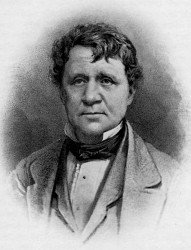 As an interesting historical aside, is that Brother Keene was a good friend of Edwin Thomas Booth. Keene and Booth worked together on the stage on numerous occasions, including at the California Theater in San Francisco. Although Edwin Booth was a well-known actor, he is better known as the brother of John Wilkes Booth, the assassin of President Abraham Lincoln. President Lincoln had four sons, only one lived beyond the age of eighteen. Robert Todd Lincoln was born in 1843, and died in 1926. He graduated from Harvard and served on General Grant’s Staff during the Civil War. While still a youth, he almost died by being pushed into the path of a speeding train. The brother of the man who assassinated President Lincoln, Edwin Booth, saved the President’s son by pulling him from the path of the speeding train.
As an interesting historical aside, is that Brother Keene was a good friend of Edwin Thomas Booth. Keene and Booth worked together on the stage on numerous occasions, including at the California Theater in San Francisco. Although Edwin Booth was a well-known actor, he is better known as the brother of John Wilkes Booth, the assassin of President Abraham Lincoln. President Lincoln had four sons, only one lived beyond the age of eighteen. Robert Todd Lincoln was born in 1843, and died in 1926. He graduated from Harvard and served on General Grant’s Staff during the Civil War. While still a youth, he almost died by being pushed into the path of a speeding train. The brother of the man who assassinated President Lincoln, Edwin Booth, saved the President’s son by pulling him from the path of the speeding train.
The Early Years
While little is known of the earlier years of the Lodge as all records of the Lodge were lost in the earthquake and fire of 1906, we do know that the first Lodge benefit was given by the Lodge at the Grand Opera House, located on Mission Street between Third and Fourth Streets. This benefit stared Thomas Keene. At the time of the institution of our Lodge there were thirty-five charter members. Within eight months, San Francisco Lodge No. 3 had grown to two-hundred members.
In 1878 the Lodge met every Sunday at 2 pm in Titles’ Hall located at 417 Bush Street.
The Elks Lodge was a source of entertainment in an era absent radio and television. Community entertainment was common and plentiful as evidenced by such magnificent public monuments as the Sutro Baths, and Playland, which were very popular. Ocean Beach was a major destination.
San Francisco was a prosperous and successful Lodge, which was held in high esteem throughout Elkdom and our City. For reasons lost in history, by 1878 internal dissension grew to such an extent, that in early 1879 a split took place, and a number of members seceded from No. 3. These disgruntled members formed a second Lodge in San Francisco. In December 1879 a charter was granted to California Lodge No. 12. Both Lodges held their meetings at Red Mans’ Hall, which was located at 510 Bush Street. This situation was the reason the Grand Lodge later enacted bylaws allowing only one Elk Lodge in any city or town, bylaws which are still in force today. On December 13, 1885 the members of the two San Francisco Lodges reconciled their differences and, once again, joined together with yet a new name and number, Golden Gate Lodge No. 6. The first Exalted Ruler of No. 6 was Henry H. Davis.
Lodge No. 6 continued with mediocre success. From the beginning they experienced a lack of funds and interest. The Lodge had a difficult time financing their activities and charities. To solve this predicament they decided to hold an annual carnival. The Lodge was able to secure the Mechanics Pavilion from the Mechanics Institute.
This building was the largest in San Francisco. The Pavilion was one square block (62,480 square feet of usable floor space) located where the current Bill Graham Theater now stands. These annual events were very elaborate. They included parades, aerobatic feats, skate and bicycle races, and even floats. The first carnival was held in 1893 and attracted over 2,000 people. They were so successful that the Lodge became financially secure enabling them to purchase a new plat at the cost of $3,000, near the old plat at Laurel Hill Cemetery, on the seventeenth anniversary of the establishment of an Elks Lodge in San Francisco. Laurel Hill was located at Bush Street and Presidio Avenue (the location of the old Firemen’s Fund Building) where twenty-two Brother Elks had already been buried. Eventually concerns over public health and widespread vandalism would prompt San Francisco to outlaw further burials in 1902. Laurel Hill, as well as the other cemeteries in the City, were told to remove their bodies. These organizations fought until 1942 when all of the bodies were finally exhumed, including our Brother Elks, and moved to Greenlawn Memorial Park in Colma. The Odd Fellows would later donate their Greenlawn plots to San Francisco Lodge No. 3. Approximately 120 Elks are currently buried at this site, with 100 plots still available to fellow members. Our memorial also includes a columbarium in which the ashes of our deceased members are reverently stored.
Another rift in the Lodge occurred in January 1896. This rift regarded what one faction considered to be immoral behavior occurring during the annual carnival, where they disapproved of what they perceived to be forms of gambling and other debauchery. After negative articles appeared in the local press some members attempted to prevent any future carnivals. The other side argued for the carnivals, and insisted that the press was slandering them.
Those arguing for the carnival further maintained that the activities at the event would compare favorably with like activities in similar cities. In reviewing the accounts of the descriptions of the morality of the carnivals in the “The Antler” from that period, the editor at one point defends the actions, and then later denounces them. Later Grand Exalted Ruler Meade Detweiler would write, “The inception of the difficulties in Golden Gate Lodge was in consequence of a yearly ball of a disreputable and disgraceful character, which, to a certain extent, under the auspices of some of the Elks, through the onus of its shame upon the entire brotherhood of San Francisco.” He further stated that the procedures “transcended the strict bounds of legality.
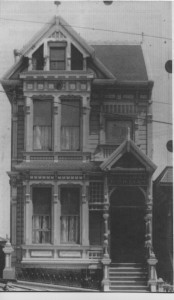 This situation came to a head when during a meeting when members balloted for a candidate named William Cronin. A claim was made that the balloting of the candidate, and therefore the election itself, was illegal, alleging that Cronin lied about his age. One can only surmise that Candidate Cronin came down heavily on one side of the issue, and was therefore opposed by the opposition. This discussion continued at a subsequent meeting when a member of the Lodge, by the name of Ullman, who was also the current District Deputy, and therefore a representative of the Grand Lodge, was suspended by the Lodge for violation of article 68 of Grand Lodge Law (conduct unbecoming a gentleman during a session). The Lodge misconstrued this section to mean that they had the authority to suspend District Deputy Ullman from membership in the Lodge.
This situation came to a head when during a meeting when members balloted for a candidate named William Cronin. A claim was made that the balloting of the candidate, and therefore the election itself, was illegal, alleging that Cronin lied about his age. One can only surmise that Candidate Cronin came down heavily on one side of the issue, and was therefore opposed by the opposition. This discussion continued at a subsequent meeting when a member of the Lodge, by the name of Ullman, who was also the current District Deputy, and therefore a representative of the Grand Lodge, was suspended by the Lodge for violation of article 68 of Grand Lodge Law (conduct unbecoming a gentleman during a session). The Lodge misconstrued this section to mean that they had the authority to suspend District Deputy Ullman from membership in the Lodge.
In reality, section 68 only gave them authority to suspend the errant individual for the duration of the meeting in which he erred. On June 12, 1896 the Grand Exalted Ruler suspended Golden Gate Lodge No. 6. After review by a committee of the Grand Lodge, it was determined that the action of the Grand Exalted Ruler was correct and the suspension of the District Deputy was void. The situation was so grave, that on the night of July 15th, members unknown entered the Lodge room, broke the seals on the safe, and removed the records, ritual and seal, and hid them. The Grand Lodge decided that Golden Gate Lodge No. 6 be suspended until the incoming Grand Exalted Ruler could make the determination when to remove such suspension. To resolve this situation, the Grand Exalted Ruler visited San Francisco in August 1896 to investigate the matter.
The newly elected Grand Exalted Ruler was Meade Detweiler. He arrived in San Francisco on August 15, 1896 and spent two weeks analyzing the situation, and finally arriving at, what by all accounts, was an equitable and logical solution. Brother Detweiler met with Elks from the suspended Lodge No. 6, as well as Elks from other California Lodges and reputable non-Elk members of the community. He then held a meeting at the Lodge on August 18th, to which all members of No. 6 were notified and invited. Sixty-eight members attended this meeting. At this session it soon became apparent that the two sides of the issue were so polarized that reorganization of the old lodge would be unrealistic. After a long discussion, a member who name is lost to history, and who was not aligned with either faction made a motion that Lodge No. 6 be reorganized under the original name and number, San Francisco Lodge No. 3.
The decision as to which members would be allowed was left to the Grand Exalted Ruler. This motion was unanimously carried. Following this, GER Detweiler called on numerous community and business leaders who became charter members. Detweiler then scrutinized the rolls of No. 6, and excluded all of those he deemed to be leaders of both clashing factions. From these lists the charter roll was formed San Francisco Lodge No. 3 was re-instituted with seventy-nine members. The Grand Lodge ratified the actions taken by Detweiler and a charter was issued to San Francisco No. 3 on August 24, 1896. At the same time the charter of Golden Gate Lodge No. 6 was revoked, continuing the continuity of the proud history of a lodge in San Francisco. The new Exalted Ruler ofNo. 3 was Brother J. R. Howell of No. 10 Montgomery Street, and the new Secretary was Harrison Houseworth of No. 832 Market Street.
Grand Exalted Ruler Detweiler was highly praised by the Grand Lodge and Elks throughout the country for his handling of this affair. His actions were unanimously endorsed and ratified at the next Grand Lodge session in Minneapolis on Thursday July 8, 1897. Since all members of both factions agreed to abide by the decisions of the Grand Exalted Ruler, it was assumed that this agreement would have been the end of the controversy, but it wasn’t.
When the members of No. 6 purchased a new plot at the Lauren Hill Cemetery in December 1894 the members of Golden Gate No. 6 thought it a good idea to incorporate as a fraternal organization under the laws of the State of California. At a meeting held in December, a resolution to incorporate was proposed, seconded, and passed that No. 6 incorporate. The certificate of incorporate and the election of officers of such that incorporation was filed with the Secretary of the State of California, and a certificate of such fact was issued to the Lodge. This action is only the first of many that are necessary to form a corporation. No further actions were taken. There were no bylaws, no rules or regulations were adopted, and no property was transferred to the corporation. After the Grand Lodge certified No. 3 as the only recognized Elks Lodge in the City, the non-selected, or non-admitted members of the old lodge decided to hold meetings under the incorporation papers of Golden Gate Lodge No. 6. They initiated between one hundred and one hundred and fifty candidates for one dollar each, and advertised themselves as a regularly authorized organization of the BPOE, and their “social session” and entertainments in the local press. Since approximately two thirds of Golden Gate No. 6 were now members of San Francisco No. 3, the “incorporated Lodge” could not complete the requirements of becoming a corporation because only one third of the members at the time of the certification were actually members. When G.E.R. Detweiler revoked the Charter of No. 6, he took procession of the property for safekeeping, including $3,222.35, from which a few bills were paid and refunds made. The remaining of which was accounted for and currently being held in a safe. An attorney for “the corporation, by the name of Henry Davis, filed suit in San Francisco courts against the Exalted Ruler, the Secretary and the three Trustees of the old Lodge, charging them with the unlawful conversion of personal property. The court postponed the trial until August. The Attorney General, on behalf of the State, began proceedings against the members of No. 6, to show what right they had to perform any actions as a corporation. A lawsuit was also filed by San Francisco No. 3 against the incorporated Lodge, attacking the validity of the corporation. Judge Seawell finally decided this suit in favor of No. 3, and the incorporation of Golden Gate Lodge No. 6 was declared invalid and of no effect. Soon thereafter the defunct members of No. 6 stopped all meetings.
On Friday evening September 17, 1897 the first “social session” was held since the receipt of the reissued charter. Following are descriptions from this event which was held after a brief business session. The session was also the occasion of an informal session for Brother William Crane of St. Louis Lodge No. 9, and Brother Rogers of Brooklyn No. 22. A committee in carriages escorted Brother Crane and several members of his company from the theater to the hall. A second committee in “tally-hos” (a type of fancy carriage) escorted Brother Rogers along with forty members of the Mechanic Institute Fair Band, along with their board of directors, “arriving too late to celebrate the eleven o’clock toast, but in plenty of time to enjoy the mental and musical feast, to say nothing of the liquids which followed.” Exalted Ruler J. R. Howell acted as the master of ceremonies. Among the Brothers present were Captain Randolph Dickens and Lieutenant Austin Davis of the U. S. Marine Corps, both attached to the Battleship Oregon. Among the entertainment were numerous songs, instrumentals, and short speeches. At this event No. 3 accepted a challenge of a baseball game from Oakland Lodge No. 171. The account goes on to say that “the only regrets expressed were that the sun came up too soon.”
In 1898 our Country was embroiled in the Spanish American War. During the spring and summer month’s 12,000 soldiers were sent to the Presidio of San Francisco, in order to be processed and shipped to the Philippines. These months are cold and foggy in the city, and most of the soldiers lived in tents. San Francisco Elks did what they could to make these soldiers more comfortable. On one such occasion, Oakland Lodge No. 171 (at that time our closest Brother Lodge) joined us in giving a “military reception”. The reception was held at the Elks Hall (a rented building located at 223 Sutter Street). By seven-thirty the hall was filled with Brothers from all over the country. An article in the Antler dated June 8, 1898, described the uniforms of the day by stating “the blue coats and gold lace gave a warlike tinge to the scene and made a strong contrast to the immaculate dress worn by the civilian Brothers”. The same article stated “Brother Judge Advocate Charles L. Jewett, U. S. Army, made a very touching address, speaking of the soldiers’ visit to California, and amid loud applause stated that on the arrival of the troops in Manila immediately an Elks Lodge will be formed if it were possible to secure a secluded spot or even an umbrella to mark the Elks headquarters”. The session included refreshments, which were served by waiters, along with patriotic songs, speeches, and music. This gathering ended at 12:00 midnight because the soldiers had to return to quarters before curfew, which was 12:30. In 1902, Manila, Philippines Lodge No. 761 was founded in that City.
One of our Brothers who had a great influence on our early history was Past Grand Exalted Ruler Meade Detweiler (the man who settled the No. 6 Lodge dispute). In 1901 he was a member of Harrisburg Lodge No. 12. , which temporarily lost its charter. Brother Detweiler deposited his Grand Lodge card which authorized him to join any Lodge in the Order. It is to our Lodge’s credit that he chose to join San Francisco Lodge No. 3. Exalted Ruler Tom Dunne brought his name up for a vote which was enthusiastically received. The members eagerly elected him. Immediately after the affirmative vote, a motion was made to make him a life member, at which time all members present rose to second the motion. His record is currently in our files stating succinctly, his name, Stamped “Life Member 1901,” and “died 1905.”
(Note the champagne served by the quart)
The Earthquake
At 5:16 am on April 18, 1906, San Francisco was shaken for 47 seconds by an earthquake which measured nine points on the Richter scale. The size and duration of an earthquake of this magnitude would be devastating to many cities today, even with stricter and more modem building standards. In the San Francisco of 1906, the majority of buildings were made of wood, a material considered to be desirable in a city which normally experiences fifteen “minor” earthquakes a year, because of its flexibility. A great deal of the city was built on landfill, much of which was the hulls of abandoned wooden ships deserted by crews who left in search of gold.
San Francisco had a new six million dollar city hall, which was made of stone and brick, and immediately collapsed (although later this became a political scandal, due to faulty building supplies, and may have had more to do with graft than movements of the earth). When the earth finally stopped shaking, many of the wooden structures were still standing, surviving the earthquake, only to be destroyed by the ensuing fire.
At the beginning of the quake, the top of the California Hotel (the hotel in which GER Detweiler stayed in 1896,) fell on a firehouse where the fire chief slept, burying him in rubble and killing him instantly. The quake severed all water mains leaving only one fire hydrant functional in the entire city. In some cases, where available, fire fighters used water from local cisterns, sewers, and the Bay. That single functional fire hydrant is located on 20th and Church Streets and is commemorated with a plaque and special gold paint. This fire continued the destruction of the city, until the mostly unimpeded flames, burning for three days, finally devastated 3,400 acres. It is difficult to say how many of the 28,000 destroyed buildings were actually ruined by fire, and how many by the quake. This confusion was in large part due to police reports made at that time. It was generally understood the majority of the capital needed to rebuild the city would come from back East, authorized by people who never experienced and thus greatly feared earthquakes. Additionally, most insurance companies did not cover earthquakes.
Many policemen “assisted” their citizens and neighbors by stating that the causative factor of the destruction of the homes was fire, and not the earthquake. Regardless of the causal factor, over half of San Francisco’s 450,000 residents lost their homes, 650 died, and an additional 350 were missing.
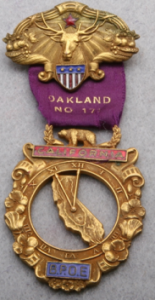 Since the time of San Francisco Lodge’s conception they were in leased facilities in downtown San Francisco. They were meeting at 223 Sutter Street at the time of the earthquake. The Sutter Street building was totally destroyed.
Since the time of San Francisco Lodge’s conception they were in leased facilities in downtown San Francisco. They were meeting at 223 Sutter Street at the time of the earthquake. The Sutter Street building was totally destroyed.
Many San Francisco members lost property and places of business, as well as personal wealth. Fortunately, based on local records, it appears that no San Francisco Elks or their families were killed in the disaster. Lodge members went to work to help their community. In all of this, Oakland Lodge No. 171 responded immediately with a tent city that was housing over 2,000 and feeding close to 5,000 within two days of the earthquake. San Francisco Lodge No. 3 set up soup kitchens for the public. San Francisco Elks were continually providing any assistance that might be needed. A personal letter written by an official of an Elk’s Lodge from “the middle states” wrote of one such account to the Editor of the Elks Antler. He had a married sister living in San Francisco who had young children, and whose husband had lost his livelihood. While seeking relief from the fire zone, she along with many others, was waited on by an Elk. This volunteer asked if her family was in need of food, medicine or any other attention. He had no way of knowing that the woman in need was a relative of an Elk. He was only one member of a committee of Elks, who were seeking out those in need of aid. This Good Samaritan did not even leave his name; but instead told the young lady “call at our headquarters and your wants will be supplied.”
At the time of this catastrophe the Grand Exalted Ruler was Robert W. Brown. Upon hearing the reports “over the clicking of the telegraph” in his office, he immediately departed for California on the first available train. Ten-thousand dollars ($10,000) was secured from the Grand Trustees, and money began pouring in from Lodges all over the country. GER Brown arrived in Oakland, where the base relief operations were established. When he arrived he found that a committee of one thousand Elks had already been organized. Assuming personal charge of the relief, Brown appointed a commission consisting of Henry A. Melvin, Oakland Lodge No. 171, , Percy V. Long, San Francisco Lodge No. 3, and Ralph Hagan, Los Angeles Lodge No. 99. In the words of California State Governor George Pardee “The Elks were first to render assistance and had valiantly headed the relief procession ever since.” Within 12 hours following the disaster, the Elks had equipped a tented city, and hospitals, and were taking care of approximately 2,000 people in these facilities alone. Provision wagons from Oakland were the first to enter San Francisco. The damaged homes of Elks were opened to those less fortunate. So much money was coming in for disaster relief from Elks Lodges that at no time was it lacking, while at the same time, consignments of food were pouring in by the carload from adjacent Lodges. As exodus trains began rolling eastward filled with survivors, Elks were at most stops, on every route with food and hot coffee to feed the travelers. Elk supply houses were filled, emptied, and filled again. Petaluma and Vallejo Elk Lodges were feeding and sheltering the multitudes who fled San Francisco. To succinctly sum up the good works the Elks accomplished during this crises, it is simplest to once again quote Governor Pardee, when he said about our Order “without their aid I do not know what we would have done during the first hours of the catastrophe.”
To illustrate how thoroughly and quickly San Francisco Lodge No. 3, and the City itself bounced back, the following article appeared in a Lodge circular dated March 11, 1907,
“The annual banquet of this lodge will take place on Saturday evening, April 20, 1907, at the Fairmont Hotel. The date of the banquet will be set exactly one year after the banquet of 1906, which was unavoidably postponed, makes this, from a sentimental view, of more than usual interest. Our banquet also opens this magnificent hotel, and the banquet room is the most beautiful in existence.”
After the destruction of 223 Sutter Street, the Lodge moved to a Victorian house located at 818 Hayes Street.
Growth Continues
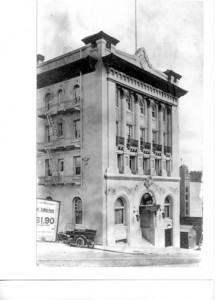 The membership had now reached eight hundred. It became obvious that a new location would soon have to be found. A House Committee was formed to search for a possible new location. By April 1908 the Lodge purchased a lot on Powell St, between Sutter and Bush Streets. This lot was a typically sized San Francisco lot at 50′ x 137′ and cost $26,000.
The membership had now reached eight hundred. It became obvious that a new location would soon have to be found. A House Committee was formed to search for a possible new location. By April 1908 the Lodge purchased a lot on Powell St, between Sutter and Bush Streets. This lot was a typically sized San Francisco lot at 50′ x 137′ and cost $26,000.
Ground was broken for the new building on November 21st, 1908. As soon as the ceremonies were complete, the architect, Mr. A. Cantin, began construction. This building would be of Spanish Renaissance design with mission features. This is a design fitting with California history, and a type of design, which would also be used in the current building. On March 27, 1910 the new Lodge at, 540 Powell Street, was dedicated. Many of San Francisco’s leading citizens were on hand for the dedication, including Mayor Phelan. 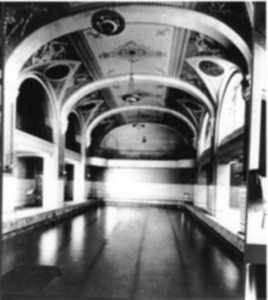 The four-story building had cost $125,000 with an additional $35,000 added for furnishings. The basement housed the “high jinks” room (ballroom) with a stage, measuring 46′ wide, 110′ long with 18’ceilings. On the first floor were business offices, a billiard room, library, dinning room, kitchen and more. On the second floor were twenty-two bedrooms for bachelor Elks, with one bathroom for every two bedrooms. On the third floor was a Lodge room 45′ wide, 60′ long and 35′ high, extending through the fourth floor. The room had Gothic windows with a stained glass dome in the ceiling. Bedrooms were also located on these floors, with elevators servicing all floors. The stained glass dome was designed and hand fabricated in Italy. For reasons unknown, the Lodge No. 3 never took delivery of the dome and it was eventually adorned the Stockton Lodge No. 218.
The four-story building had cost $125,000 with an additional $35,000 added for furnishings. The basement housed the “high jinks” room (ballroom) with a stage, measuring 46′ wide, 110′ long with 18’ceilings. On the first floor were business offices, a billiard room, library, dinning room, kitchen and more. On the second floor were twenty-two bedrooms for bachelor Elks, with one bathroom for every two bedrooms. On the third floor was a Lodge room 45′ wide, 60′ long and 35′ high, extending through the fourth floor. The room had Gothic windows with a stained glass dome in the ceiling. Bedrooms were also located on these floors, with elevators servicing all floors. The stained glass dome was designed and hand fabricated in Italy. For reasons unknown, the Lodge No. 3 never took delivery of the dome and it was eventually adorned the Stockton Lodge No. 218.
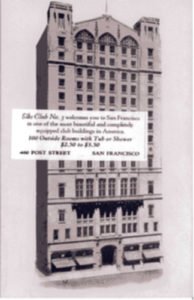 By 1923 the building had grown too small for the growing membership and a new building on Post Street was commissioned. Past Grand Exalted Ruler William Abbott was the person in charge of the Building Committee. During a meeting in 1923 he proposed the construction of a new Lodge building. This proposal was so enthusiastically received by the membership, that within twenty minutes of the proposal, the members pledged $68,000 for bonds. The remaining of the financing would come from the Pacific Union Life Insurance Company. Once again the Lodge was to be of Spanish-Gothic design. The building committee selected architects Frederick H. Meyer and Albin R. Johnson. Anticipating a continuing growth in membership, the Building Committee, wisely, insisted that the new building be designed with the capability of adding additional stories in the future, a possibility which has recently been considered by our Board of Trustees. Since we are solely an American Organization, the Committee also specified that all construction materials and furnishings be American made. Groundbreaking ceremonies were held on August 25, 1923, with the General Contracting firm of Ralph McLerain beginning construction the following day. The project had a final cost $1,500,000. Our new (and current) building, at 450 Post Street, was dedicated on May 27, 1925, to the 3,000 members of the Lodge. The ceilings in the main dinning room are hand painted ceramic. The ceilings over the twenty-seven by seventy-five foot swimming pool were hand painted tile. This ceiling was two stories high from the basement, with a gallery on the first floor, overlooking the pool. The fifteen-story building contained 100 bedrooms for resident members and visiting Elks. Our main Lodge room, which is now the Post Street had a seating capacity of 1,000 with a projection room, maple stage, and pipe organ. The Lodge also boasted a billiard room, library, bakery, gym, barbershop, steam room and much more. Since some of the Grand Lodge Officers were attending a convention in Portland Oregon at the time of the dedication, there was a formal dedication on July 22, 1925, so that some of these officers would be able to attend.
By 1923 the building had grown too small for the growing membership and a new building on Post Street was commissioned. Past Grand Exalted Ruler William Abbott was the person in charge of the Building Committee. During a meeting in 1923 he proposed the construction of a new Lodge building. This proposal was so enthusiastically received by the membership, that within twenty minutes of the proposal, the members pledged $68,000 for bonds. The remaining of the financing would come from the Pacific Union Life Insurance Company. Once again the Lodge was to be of Spanish-Gothic design. The building committee selected architects Frederick H. Meyer and Albin R. Johnson. Anticipating a continuing growth in membership, the Building Committee, wisely, insisted that the new building be designed with the capability of adding additional stories in the future, a possibility which has recently been considered by our Board of Trustees. Since we are solely an American Organization, the Committee also specified that all construction materials and furnishings be American made. Groundbreaking ceremonies were held on August 25, 1923, with the General Contracting firm of Ralph McLerain beginning construction the following day. The project had a final cost $1,500,000. Our new (and current) building, at 450 Post Street, was dedicated on May 27, 1925, to the 3,000 members of the Lodge. The ceilings in the main dinning room are hand painted ceramic. The ceilings over the twenty-seven by seventy-five foot swimming pool were hand painted tile. This ceiling was two stories high from the basement, with a gallery on the first floor, overlooking the pool. The fifteen-story building contained 100 bedrooms for resident members and visiting Elks. Our main Lodge room, which is now the Post Street had a seating capacity of 1,000 with a projection room, maple stage, and pipe organ. The Lodge also boasted a billiard room, library, bakery, gym, barbershop, steam room and much more. Since some of the Grand Lodge Officers were attending a convention in Portland Oregon at the time of the dedication, there was a formal dedication on July 22, 1925, so that some of these officers would be able to attend.
100 years of Elks in Hawaii: Hawaii Entertains at San Francisco Elks Lodge Opening San Francisco July 1925:
Newspapers report Santa Barbara’s efforts to rebuild after a June earthquake and plans for the state’s Diamond Jubilee. The stock market climbs; only a few caution the rise can not go on forever. The Dayton, TN, trial of high school science teacher John Scopes, accused of teaching evolution, holds the front page for weeks. In federal court, those who lost fortunes in the World War alien property seizure of Hawaii’s Hackfeld Co. (American Factors / Liberty House) sue for recompense.
Hawaii Elks, visiting the city before the Portland Grand Lodge meeting, attend Lodge 3’s July 10 meeting in new, sumptuous quarters on Post St. One attraction of a west coast visit for Hawaii folks was seeing films before they reached Hawaii. Brother Elks thinking to share a flick could chose from DeMille’s The Ten Commandments, Douglas Fairbanks in Thief of Bagdad, or The Lost World, Arthur Conan Doyle’s story of a modern land where dinosaurs still roam. Entertainment news hyped the pairing of Lost World and Scopes Monkey Trial. Hawaii Elks may have suggested the new comedy, Grounds for Divorce screening at the California theater a few blocks from Lodge 3. Doubtlessly San Francisco Elks said, No thanks. We’ve seen the other film. 616 Elks refocusing on the ad saw a familiar title and name: A Trip to the Hawaiian Islands, William F. Aldrich.
In May 1925 Lodge 3 had several first nights in their new building. One member’s night included showing Aldrich’s film with performance and encores by singers and dancers. The Lodge arranged a second show to which Elk wives were invited the following week. Word spread in theater circles and A Trip to the Hawaiian Islands opened at the prestigious California theater July 4th. Moving to Oakland’s Franklin theater later in July, ads touted: Tremendous Sensation; Direct from stupendous success at San Francisco’s California Theater. Bill Aldrich zipped in and out of Hawaii filming travelogues, gathering entertainers, then returning to the mainland to tour the results. He experimented with short films including 1918’s Poi or Bust, the Sonny Cunha comedy. In mid-May 1918, Aldrich exhausted the audience for his self-produced films and his temporary Airdome theater at Nuuanu & Pauahi Sts. withered away. Aldrich was a favorite of Hawaii tourism groups and the Ad Club. He traveled across the mainland to theaters small and large showing his Hawaii travelogue supported by live entertainers, Aldrich’s Imperial Hawaiians. His shows advertised Hawaii, correcting common erroneous beliefs (an active volcano on Oahu). In a letter to the Advertiser, he boasted his film and troupe reached 1 mil. people in a few months. He touted 400,000 viewers in greater Chicago. Of the 1925 show self-promoter Aldrich bragged: the show I brought over promises to be one of the outstanding publicity stunts of the year for the islands. Aldrich did live narration, complimented by singer/dancers Frank and Helen Andrade, James Kualii, Joseph and Lucy Lopes.
Wife Peggy Aldrich often acted as road manager. In 1926 Bill and Peggy each operated a company of singer-dancers plus the now hour long film. She returned to Oahu to recruit high grade Hawaiian musicians for a third group. The coming season would feature after each performance a drawing for a free trip to Hawaii. In 1930, Aldrich left the road – in a way. He created a Hawaiian village at Atlantic City on the famous steel pier, a few feet from the Boardwalk. Aldrich came home to recruit musicians and divers. Bill wanted a chap who can take a header from 100 ft. up, turn a couple of somersaults, and land safely and gracefully in the water. The Ad Club, including 616 Elks members, got behind this living advertisement for island tourism by holding a shower for Aldrich. Club members were urged to bring fish nets, calabashes, surfboards, poi pounders, fans, mats and anything else available to help Bill with an ‘Extreme Makeover: the village. The 20 member troupe traveled from CA to NJ in just 7 days living in a Mack bus converted to a rolling motor home.
Tourism groups wanted a presence at Atlantic City: a city of tourists…filled year round with just the sort of people our Hawaii advertising campaign should reach. The Hawaii Promotion Committee had a presence on the Steel Pier as early as 1910 – singers/ dancers/ divers/ fresh pineapple. One Hawaiian dance troupe performed at an east coast Elks event, before being banned by pier management as objectionable. Adventurous Hawaiians kept diving off the Steel Pier. Among many: 1930s dancer Harriet Keonaonalaulani Purdy Kauaihilo, aka Hawaiian Human Cannonball; 1940s – composer, musician John Kamano dove 115 feet, cigar in mouth, holding an umbrella!
Descriptions of Al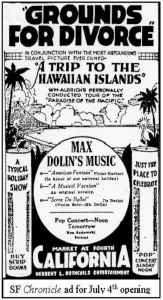 drich meet the central casting image of a Hollywood mogul: If things go right, Bill chews more cigars and wears the biggest of smiles. When things are not breaking right there is no cigar in Bill’s mouth and he’s a grim looking individual. Reportedly, the San Francisco Elks Lodge 3 opening day destroyed 20 cigars!
drich meet the central casting image of a Hollywood mogul: If things go right, Bill chews more cigars and wears the biggest of smiles. When things are not breaking right there is no cigar in Bill’s mouth and he’s a grim looking individual. Reportedly, the San Francisco Elks Lodge 3 opening day destroyed 20 cigars!
Anita Manning, Lodge Historian
References:
616 Minutes 1925 Apr 17
Advertiser 1918 May 12; 1925 May 27; 2002 Nov 9
Aloha Elk 2006 Feb Sonny Cunha – Movie Star Elk
Hawaii Newspaper Agency Morgue
Paradise of the Pacific 1910 23:5; 1916 29:11
San Francisco Chronicle 1925 Jul 4, 10
Star Bulletin 1925 May 26, Jul 11, 13; 1926 Sep 4; 1930 Apr 4, 5
Todaro, T. 1974 Golden Yrs of Hawn entertainment.
San Francisco Lodge No. 3 continues to be an active and vibrant Lodge, making valuable contributions to their community. The End.

